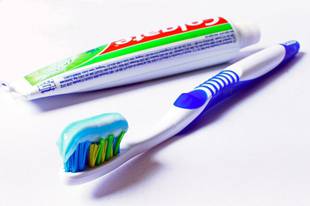
You have seen commercials telling us that toothpaste protects our teeth. With the help of over-simplified animation aimed at young viewers, advertisers try to tell us how this is so. But what really happens when we brush our teeth? What does the toothpaste really do to protect our teeth?
Dental enamel or the hard glossy covering that surrounds our teeth is mainly made of hydroxylapatite, which is composed of calcium, phosphate and hydroxide. The attack on the enamel by acids normally present in the mouth, such as lactic or acetic acid, tends to dissolve the enamel and produce carries or tooth decay. When we brush our teeth, we use toothpaste containing fluoride ions. Through chemical reaction, the fluoride ions replaced the hydroxide ion in the enamel. Thus in the presence of fluoride ion, insoluble calcium fluoride forms, and the process produces a layer of fluorapatite. The fluoride-treated enamel became more resistant to acid attack.
Tin fluoride, which is particularly effective in treating teeth to reduce the rate of dissolution of enamel in acid solution, is a constituent of many types of toothpaste. The increased protection in the presence of tin ions is attributed to the absorption by the fluoride-treated enamel of very thin layer of basic tin phosphates.
The fact that teeth are composed chiefly of hydroxylapatite is actually the basis for the fluoridation of water. Apparently the proper amount of fluoride ions in the water promotes the formation of teeth that are especially resistant to decay by increasing the fluoride ion content and decreasing the hydroxide and chloride ion content of the enamel. This is incorporated in the formulation of fluoride toothpaste.
In one laboratory test, extracted teeth were exposed to a buffered lactic acid solution, and the rate of dissolution of enamel was measured. Different samples of teeth were then treated with one of two fluoride solutions of different concentration and the rates of dissolution were again measured. The result is a high reduction in the dissolution rate, that is, the teeth were significantly protected by the fluoride solution during the standard exposure time of the test.
Toothpastes are not meant only for cleaning the teeth and gums, but are chemically formulated for the protection of the teeth's enamel.

















